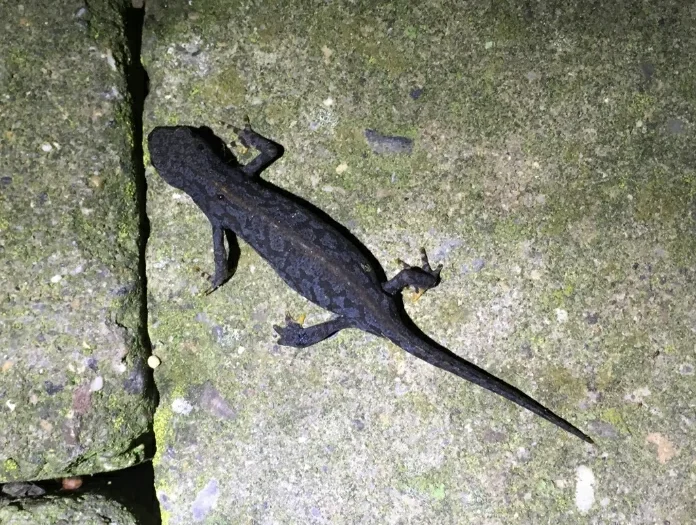You might think newts spend all their time in water or crawling around on the ground. But if you’ve ever kept one in a tank, you might wake up to find it sitting on top of the lid, or even outside the tank. That makes you wonder: can newts really climb walls?
Yes, newts can climb walls. They have special toe pads with tiny structures that help them hold onto smooth surfaces like glass, plastic, and even some wood. Some newts are surprisingly good at climbing and can escape from tanks without secure lids.
It surprises a lot of newt owners. What looks like a clumsy animal can actually crawl up the side of a glass tank without much trouble.
How Newts Climb Vertical Surfaces
Newts use special parts on their feet to climb. Their toes have small pads with tiny structures that let them grip smooth surfaces.
These pads aren’t sticky like glue, they work more like suction cups.
Fire belly newts, for example, can even stick to wet, slippery surfaces while hanging upside down.

The tiny hairs on their toe pads grab the surface enough to hold their weight.
When a newt climbs, it moves slowly and carefully. Each foot is placed with attention, and the toe pads spread out to touch as much as possible.
This isn’t a fast scramble like a lizard. It’s a slow, steady crawl upward.
The moisture on their skin actually helps.
Wet skin makes a thin film between their body and the surface, which helps them stick better.
What Surfaces Can They Climb?
Not every surface is easy. Newts can climb smooth glass, plastic, and acrylic pretty easily.
That’s why escaped newts are so common.

Wood is hit or miss. Smooth, finished wood can be climbed, but rough wood makes it harder.
The texture either helps their grip or stops it from working right.
Painted walls are tricky. Smooth, shiny paint can work, but flat or rough paint is harder. Some determined newts still manage it.
Really rough surfaces like brick, stone, or stucco are tough. Their toe pads work best on smooth stuff.
But if there are cracks or little holes to grab, they might still make some progress.
Why Do They Try to Escape?
Newts don’t climb just for fun. If a newt tries to escape its tank, something in the tank isn’t right.
- Poor water quality is a big reason. Too much ammonia, nitrites, or other chemicals makes them want out.
They don’t know they can’t survive outside, they just know they need to leave.
- Wrong temperature can make them climb too. Most newts like water between 60 and 70 degrees Fahrenheit.
If it gets too warm, they’ll climb looking for cooler spots.
- Stress from other tank mates can also make them try to escape.
If they’re fighting over space or food, the weaker newt might climb out to get away.
- Sometimes, they’re just following their natural instincts. Some newts leave water during certain times of the year to live on land.
If your newt is in that land phase and you keep it in a fully water tank, it’s going to try to get out.
Different Newts Climb Differently
Not all newts climb the same. Fire belly newts are probably the best. They can climb glass walls and hang upside down if they want.

- Rough-skinned newts are also good climbers.
They leave the water to hunt on land, so they’ve learned to get over logs, rocks, and obstacles.
- Paddle-tailed newts aren’t as good. They stay in the water most of the time, so they haven’t built the same skills.
They can climb a bit, but glass walls are harder.
- Great crested newts are in the middle. They can climb if they need to but aren’t as steady as fire bellies.
They do better on textured surfaces than smooth glass.
How High Can They Go?
There isn’t really a set limit. People have found newts several feet up walls, above their tank.
One was even seen climbing a house wall almost 4 feet high, probably chasing insects near a light.
The main limit is energy. Climbing takes effort, and newts can’t go forever.
They usually stop when they find a resting spot or run out of steam.
In a tank, a newt can easily climb from the water to the top.
Most standard tanks are 12 to 24 inches tall. Without a tight lid, your newt is gone.
How to Stop Them From Escaping
You need a secure lid. No exceptions. Even happy, content newts will sometimes explore.
The lid should fit tightly with no gaps. Newts can squeeze through small openings. If there’s room for their head, they can usually get the whole body through.
Mesh lids work well, they let air through and keep newts in. Make sure the holes are small and the mesh is secured all around. Newts will find any weak spots.
Glass or acrylic lids work too, but you need ventilation. Drill small holes or leave a gap covered with mesh.
Without airflow, the tank can get too humid and cause problems.
Weight the lid if you can. Some newts are strong enough to push up a loose lid.
Something heavy on top or clamps keeps it from moving.
What Happens If They Escape?
An escaped newt is in danger. They can survive out of water for a while, but their skin needs moisture.
In a dry house, they’ll start losing it fast.
If you find one, pick it up gently and put it back in the tank.
Check for injuries, falls can hurt them. Look for cuts, missing toes, or other damage.
After putting it back, watch it for a few days. Stress can make them sick.
Make sure it’s eating normally and acting like itself.
Then figure out why it escaped. Check the water, temperature, and setup.
Something made it want out, and you need to fix it so it doesn’t happen again.
Is Climbing Normal for Newts?
In the wild, many spend part of their lives on land. They’re amphibians, which means they live in water and on land at different times.
During breeding season, many move to ponds to mate and lay eggs.
Outside that time, they often live under logs, rocks, or leaves. To get around, they need to climb obstacles.
So climbing isn’t unusual. It’s a natural skill they use to survive.
Problems happen when tanks don’t give them what they need, and they use their skills to escape.
Conclusion
Newts can climb walls, especially smooth surfaces like glass and plastic.
Their special toe pads give them grip that surprises a lot of people.
This makes secure lids really important. But more than that, it shows that newts are interesting animals with needs.
When those needs aren’t met, they’ll use their natural abilities to get out.
Hi, my name is Ezra Mushala, i have been interested animals all my life. I am the main author and editor here at snakeinformer.com.

